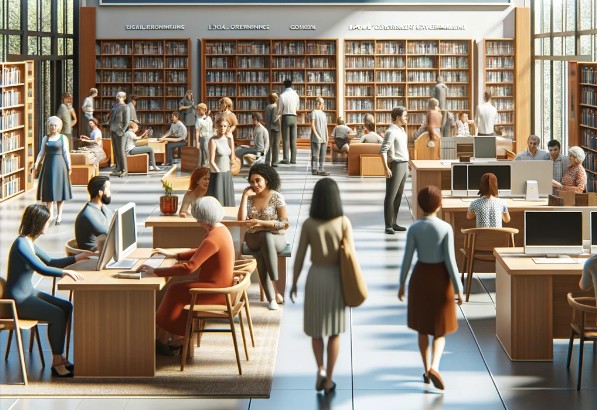Page Sections
Telling Our Organizational Success Story
- Structural Improvements: Streamlining the organizational structure empowers our employees at every level, enabling quicker decision-making and fostering a clearer sense of purpose and direction.
- Procedural Enhancements: Refining our processes creates a more efficient and satisfying work experience for our staff, allowing them to focus on what they do best.
- Training and Organizational Cultural Improvements: Cultivating a dynamic culture is about valuing the ideas and input of our workforce, promoting an atmosphere where every voice matters and every team member feels a sense of belonging and purpose. Investing in our employees' growth through comprehensive training programs is a testament to our commitment to their professional and personal development.
- Service Improvements: We've expanded our offerings with new lines of service, elevated our customer service standards, and broadened our service scope. These enhancements provide fresh opportunities for employee innovation and ensure our clients receive superior support and a more comprehensive service experience.
Structural Improvments
These improvements refer to changes in the organization's structure, including its hierarchical levels, reporting lines, departments, and divisions. Structural change may involve reorganizing teams, creating new positions, merging departments, or establishing new organizational units.
Montgomery County Fire and Rescue Services
Integrated Health and Welfare Response Initiative

Montgomery County Public Libraries
Branch Operations Enhancement

Office of Procurement
Operational Restructuring

Alcohol Beverage Services
Inventory Control Loss Prevention Unit

Office of Grants Management
Streamlined Grant Managment

Office of Human Resources
Strategic Human Capital Optimization Initiative

Other Structural Improvements:
See dozens of other structural improvements that have been made acrosss County Government:
Telling Our Story - Structural ImprovementsProcess and Procedural Enhancements
Refining our processes translates to a more efficient and satisfying work experience for our staff, allowing them to focus on what they do best.
Department of Environmental Protection
Cured in Place Pipe (CIPP) Lining to Repair Damaged CMP Pipes

Department of Health and Human Services
eICM Onboarding

Department of General Services
Utility Bill Auditing

MC311
Resident Communications Enhancments
- Department of Environmental Protection Queue Creation: A new queue was established to handle high-volume calls efficiently, enabling quicker onboarding of agents and reducing the wait times for callers. This leads to faster connection to services, improved accuracy in service requests, and a simpler process for both customers and customer service representatives.
- Health and Human Services Internal Transfer Elimination: By removing unnecessary internal transfers, customers now experience first-contact resolution or are quickly directed to HHS experts. This change has improved service efficiency and reduced complexity for users.
- Department of Permitting Services Internal Transfer Reduction: Simplifying the scheduling process for inspections, especially when customer contact IDs are unavailable, has alleviated significant customer pain points. This results in more efficient call resolution and better operational performance.
- Knowledgebase Article Streamlining: MC311 has collaborated with other departments to refine the information provided to customer service representatives, aiming to reduce the volume and complexity of knowledge base articles. This makes it easier for customers to access county information and services and enhances the clarity of instructions for customer service representatives..
- Customer Survey Expansion: In partnership with CountyStat, MC311 is measuring customer satisfaction across various channels, which now allows for a detailed analysis of performance by department. These surveys aim to use customer feedback to refine and improve service standards countywide.
Good Things That Happened: Overall, these improvements have led to a more efficient, user-friendly experience for County residents, marked by quicker service connections, increased operational efficiency, and greater customer satisfaction


Office of Animal Services
Process and Policy Changes

Office of Racial Equity and Social Justice
Operating Budget Equity Tool (OBET)

Department of Transportation
Streamlining Transportation Demand Management Fees

Electronic Correspondence and Residential Response Form

Innovation Team & Office of Human Resources
Hiring Process Playbook

Technology & Enterprise Business Services
Business Continuity Enhancements

Other Procedural Improvements:
See dozens of other procedural improvements that have been made acrosss County Government:
Telling Our Story - Procedural ImprovementsTraining and Organizational Cultural Improvements
Cultivating a dynamic culture is about valuing the ideas and input of our workforce, promoting an atmosphere where every voice matters and every team member feels a sense of belonging and purpose.
Department of Correction and Rehabilitation
In-House Crisis Intervention Training

Revitalized Spaces, Recharged Teams

Office of Community Partnerships
Cultural Improvements

Montgomery County Fire and Rescue Services
Cross-Department Community Resilience Team

Department of Environmental Protection
GreenLight Communications Workshop Training

Office of Human Resources
Montgomery County Leadership Academy

Other Training and Cultural Improvements:
See dozens of other training and cultural improvements that have been made acrosss County Government:
Telling Our Story - Other Training and Cultural Improvements
Service Improvements
We've expanded our offerings with new lines of service, elevated our customer service standards, and broadened our service scope. These enhancements provide fresh opportunities for employee innovation and ensure our clients receive superior support and a more comprehensive service experience.Alcohol Beverage Services
Local Products Partnership

Dry January

Highly Allocated Products Distribution Expansion

Department of General Services
Going Green Initiative

Health and Human Services
Community Connect Application

Bridges to Wellness

Department of Environmental Protection Improvements
Transfer Station Radio Infrastructure Installation and Upgrade
What We Did: Installed a new radio communication system, including new radios, five repeaters, antennas, and a dedicated Wi-Fi network.Good Things That Happened: Enhanced operational efficiency and safety across the 52-acre site. Reduced programming time for radios by 97% and decreased safety incidents by 41.3%.
Hauler/Collector Licensing Application
What We Did: Transitioned the licensing process from a paper-based system to an automated online procedure.Good Things That Happened: Streamlined process from weeks to hours, reducing station traffic. Improved customer satisfaction and operational speed, and repurposed full-time employees.
Tire Tracking Application
What We Did: Implemented a tire tracking application to monitor tire disposals and ensure compliance with hazardous waste permits.Good Things That Happened: Halved the time for data collection, streamlined compliance process and provided valuable data for policy making.
Unattended Vehicle Processing Kiosks
What We Did: Installed self-service kiosks for vehicle processing at the Material Recovery Facility.Good Things That Happened: Improved accuracy in environmental reporting and operational efficiency, cutting transaction time by half and freed up staff for other duties.
Transfer Station Enforcement Application
What We Did: Developed a mobile application for recording violations and generating Notice of Violation documents.Good Things That Happened: Reduced violation processing time from 30 minutes to 3 minutes. Significantly enhanced efficiency and accuracy of enforcement operations.

Department of Transportation Service Improvements
Active School Zone Alert on WAZE App

Paint the Plow Contest

Zero Emission Bus Transition Roadmap
What We Did: A Zero Emission Bus Transition Plan was released in Spring of 2024, to ensure that the Montgomery County Climate Action Plan goal of zero emissions by 2035 is achieved. The plan will be updated regularly to reflect new funding streams and advanced technology options. Good Things That Happened: Creation of a comprehensive planning, management and tracking tool that evaluates risks and mitigation strategies; provides current and future technology and energy options; analyzes operations, capacity, and service needs; provide costs and funding sources considerations; and clearly outlines next steps for implementation. The team gained critical insights into effective strategies and innovative approaches that can be applied across similar projects. Collaboration between DGS and MCDOT allowed for an in-depth look at plans for acquiring buses, and the needed facilities and infrastructure to support them, to inform decisions.White Flint West Workaround by MCDOT's Engineering Division
What We Did: Improved roads and built new paths for biking and walking in North Bethesda. This helps the area grow and become a better place to work and live.Good Things That Happened: Invested $74 million in improvements to make this area better for business and enjoyable for people.
Woodmont Avenue and Bethesda Avenue Cycletracks by MCDOT's Engineering Division
What We Did: Built safe paths for biking and walking in downtown Bethesda.Good Things That Happened: Costing nearly $2 million, this project makes it safer and easier for people to get around without a car.
MCDOT Highway Services Tree Maintenance Program Grant Efforts
What We Did: Planted over 2,000 trees along streets and sidewalks.Good Things That Happened: With grants totaling $437,000, we added significant numbers of trees to make neighborhoods nicer and greener.
EV Charging Partnership Initiative in Public Parking Garages by MCDOT's Parking Division
What We Did: Worked with Pepco to add 16 new electric vehicle (EV) charging stations in our parking areas.Good Things That Happened: This investment in new infrastructure did not cost any county dollars and improved access to charging stations for owners of EVs.
Parking Meter Modernization by MCDOT's Parking Division
What We Did: Updated parking meters to make them easier to use and better for the environment.Good Things That Happened: These new meters save approximately $378,000 every year. They’re better for everyone who parks in the county.
Bike Match MoCo by MCDOT Commuter Services Office & Communications Team
What We Did: Started a program where people can donate bikes they no longer use to be distributed to others who need them.Good Things That Happened: This program doesn’t cost the county anything, and over 500 people have gotten bikes. It’s great for health and getting around.
MCDOT Ride With Pride Inclusion Campaign
What We Did: Launched a Pride-themed bus to celebrate inclusivity. It traveled all over the county for Pride month.Good Things That Happened: Wrapping the bus cost $8,500, which is $1,500 less expensive than usual advertising. The bus was a hit on social media and news, showing the county's commitment to equality and making public transport a welcoming space for everyone.




Department of Permitting Services
Tracking Turnaround Times on a Permitting Dashboard

Auto-Delivery of Use and Occupancy Certificates via Email

Department of Recreation Improvements
Department of Recreation Kids Day Out / Teens Day Out
Good Things That Happened: MCPS contributed $56,775, saving families a substantial amount in registration fees. 2,271 youth enjoyed safe, engaging activities for 18,168 hours, reducing unsupervised time and risky behaviors.
Department of Recreation Senior Outdoor Fitness Equipment
What We Did: Created the first outdoor fitness area for seniors in the County at Holiday Park Senior Center, featuring a variety of accessible exercise equipment.Good Things That Happened: Significant community engagement and improvement in physical and mental well-being of seniors. Received the NaCo award of Best in Class in 2023.
Department of Recreation Teen Mental Health First Aid
What We Did: Launched the first Teen Mental Health First Aid (tMHFA) program in Maryland, teaching teens how to support their peers in mental health crises.Good Things That Happened: 22 youth became certified TMHFA Youth Ambassadors, leading to the successful "VIBE Check Up" program in teen camps.
Department of Recreation Free In 23' and more in 24'
What We Did: Shifted from individual transactions to community benefit, offering free access to all Recreation and Senior Centers.Good Things That Happened: Decreased revenue by $200,000 but saw a 51.64% increase in foot traffic and a 47% rise in enrollments, enhancing community well-being and equity.

Department of Environmental Protection (DEP) Service Improvements
Eliminating Bacteria Pollution in Willet Branch

Gude Landfill Remediation

ESD BMP Public Maintenance Program
What We Did: Implemented a program to maintain stormwater management practices on County property, using sustainable planting plans.Good Things That Happened: Achieved over $500,000 in annual cost savings at one pilot site and earned recognition from the National Association of Counties and the Water Environment Federation.
Commercial Food Scraps Recycling Partnership Program
What We Did: Provided technical support and developed partnerships to facilitate food scrap recycling for commercial entities.Good Things That Happened: Successfully guided 37 partners to recycle over 1.8 million pounds of food scraps, boosting recycling efforts and customer satisfaction.
New Energy-Efficient Buildings Property Tax Credit
What We Did: Introduced a property tax credit system to encourage energy-efficient building practices.Good Things That Happened: Promoted sustainable building, aligning with the County's climate goals and supporting the needs of the building owner community.
Residential Electrification Incentives Pilot Program
What We Did: Developed a pilot program to help residents transition to efficient electric appliances and systems.Good Things That Happened: Allocated a budget of $775,000 for equitable fund distribution and direct payment upon work completion, simplifying residential electrification.
Montgomery Energy Connection
What We Did: Created a central hub for energy resources and education, funded by $1.6 million from Pepco/Exelon merger funds.Good Things That Happened: Engaged in over 92,000 interactions, promoting energy efficiency and financial assistance, exemplifying successful government-community partnerships.


Montgomery County Police Department
Drone as First Responder (DFR) Program

